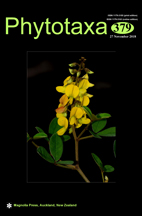Abstract
Astragalus argaeus is a critically endangered endemic species growing only on Erciyes Mountain in Kayseri, Turkey. In this study, morphology, anatomy, ecology, pollen and seed morphology and karyology of this species were investigated. The previous description of the species has been expanded and amended. Anatomically, cross-sections of root, stem and leaflet were investigated for the first time. The pith of the root is exactly covered by xylem tissue. The cross-section of stem has a periderm as the protective tissue at the outermost layer. The leaflets are equifacial (isobilateral) and amphistomatic. The pollen grains are tricolporate, isopolar and radially symmetrical, shape prolate, ornamentation faevolate-reticulate. The seeds are brownish and dark dotted in colour and oblate in shape, with rugulate-reticulate ornamentation. Number of somatic chromosomes was identified as 2n = 16 in A. argaeus. The karyotype formula of this species consists of three median chromosome pairs and five submedian chromosome pairs. The plant grows in slightly acidic or alkaline soils with loamy-sand texture, high organic matter and CaCO3 contents.

